Search results for: 'blockin'
- Related search terms
- blocking
-
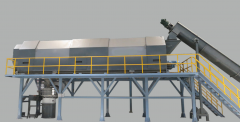 T-7018 LINE FOR PRODUCING 70 TO 150 DENIER FROM RECYCLED BOTTLEST-7018 LINE FOR PRODUCING 70 TO 150 DENIER FROM RECYCLED BOTTLES EXTRUDER Φ 160/25 PRODUCT TYPE PET-POY END/POSITION 12 ENDS POSITIONS 24 POSITIONS POSITION/SPINNING BEAM 2 POSITIONS/SPINNING BEAM POSITION DISTANCE (mm) 1500mm SPINNING PACK CYLINDER TYPE, BOTTOM MOUNTED SPINNERET DIAMETER (mm) Φ 90mm CROSS BLOWING AREA 1430mm X 1380mm GEAR PUMP SPECIFICATIONS (CC/REV) 12X3.0CC/REV GEAR PUMP QUANTITY/POSITION 1 OIL PUMP SPECIFICATION (CC/REV) 12X0.12CC/REV OIL PUMP QUANTITY/ POSITION 1 DOWTHERM BOILER/LINE 600L/65KW GUIDE ROLLER SYSTEM (DIAMETER X WIDTH) 160mm X 160mm MIGRATION JET AWA. JAPAN WINDER TWA1800-12ENDS Learn More
T-7018 LINE FOR PRODUCING 70 TO 150 DENIER FROM RECYCLED BOTTLEST-7018 LINE FOR PRODUCING 70 TO 150 DENIER FROM RECYCLED BOTTLES EXTRUDER Φ 160/25 PRODUCT TYPE PET-POY END/POSITION 12 ENDS POSITIONS 24 POSITIONS POSITION/SPINNING BEAM 2 POSITIONS/SPINNING BEAM POSITION DISTANCE (mm) 1500mm SPINNING PACK CYLINDER TYPE, BOTTOM MOUNTED SPINNERET DIAMETER (mm) Φ 90mm CROSS BLOWING AREA 1430mm X 1380mm GEAR PUMP SPECIFICATIONS (CC/REV) 12X3.0CC/REV GEAR PUMP QUANTITY/POSITION 1 OIL PUMP SPECIFICATION (CC/REV) 12X0.12CC/REV OIL PUMP QUANTITY/ POSITION 1 DOWTHERM BOILER/LINE 600L/65KW GUIDE ROLLER SYSTEM (DIAMETER X WIDTH) 160mm X 160mm MIGRATION JET AWA. JAPAN WINDER TWA1800-12ENDS Learn More -
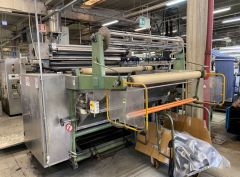 TT-1895 ZONCO OPEN WIDTH WASHING MACHINE LL4INOX COMPLETE WITH CENTERING DEVICE BIANCOTT-1895 ZONCO OPEN WIDTH WASHING MACHINE LL4INOX COMPLETE WITH CENTERING DEVICE BIANCO WASHING MACHINE FOR OPEN-CLOTHS «RAPID» LL-4 INOX HIGH QUALITY RESULTS AND COST REDUCTION THE DATA IN THIS PAMPHLET ARE GIVEN AS AN INDICATION, AND OUR COMPANY IS ENTITLED TO MODIFY THE DESCRIBED MACHINE AT ANY TIME, OWING TO TECHNICAL OR COMMERCIAL REASONS. QUANTITY: 1 Learn More
TT-1895 ZONCO OPEN WIDTH WASHING MACHINE LL4INOX COMPLETE WITH CENTERING DEVICE BIANCOTT-1895 ZONCO OPEN WIDTH WASHING MACHINE LL4INOX COMPLETE WITH CENTERING DEVICE BIANCO WASHING MACHINE FOR OPEN-CLOTHS «RAPID» LL-4 INOX HIGH QUALITY RESULTS AND COST REDUCTION THE DATA IN THIS PAMPHLET ARE GIVEN AS AN INDICATION, AND OUR COMPANY IS ENTITLED TO MODIFY THE DESCRIBED MACHINE AT ANY TIME, OWING TO TECHNICAL OR COMMERCIAL REASONS. QUANTITY: 1 Learn More -
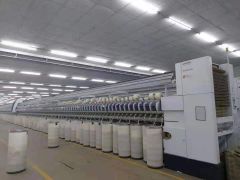 T-8176 A8 OPEN END MACHINE, 552 ROTORS, YEAR 2015T-8176 A8 OPEN END MACHINE, 552 ROTORS, YEAR 2015 A8 OPEN END MACHINE YEAR 2015 552 ROTORS PER SET SAME TIME CAN PRODUCE 3 TYPE YARN 4 PCS ROBOTS COROLAB CLEANER T633BD ROTOR CUP BD174 COMBING ROLLER MOMENT SPINNING 20S COTTON YARN MACHINE WIDTH: 1547mm QUANTITY: 2 Learn More
T-8176 A8 OPEN END MACHINE, 552 ROTORS, YEAR 2015T-8176 A8 OPEN END MACHINE, 552 ROTORS, YEAR 2015 A8 OPEN END MACHINE YEAR 2015 552 ROTORS PER SET SAME TIME CAN PRODUCE 3 TYPE YARN 4 PCS ROBOTS COROLAB CLEANER T633BD ROTOR CUP BD174 COMBING ROLLER MOMENT SPINNING 20S COTTON YARN MACHINE WIDTH: 1547mm QUANTITY: 2 Learn More -
 T-6550 MEDICAL PROTECTIVE CLOTHING BLOOD SYNTHETIC PENETRABILITY TESTER
T-6550 MEDICAL PROTECTIVE CLOTHING BLOOD SYNTHETIC PENETRABILITY TESTERREFERENCE NUMBER: T-6550
MEDICAL PROTECTIVE CLOTHING BLOOD SYNTHETIC PENETRABILITY TESTER
TECHNICAL SPECIFICATIONS AND CONFIGURATION:
1. THE INSTRUMENT ADOPTS AN AIR SOURCE THAT CAN PROVIDE (0.5 ~ 30±0.1) KPA PRESSURE TO CONTINUOUSLY PRESSURIZED THE SAMPLE, WHICH IS NOT RESTRICTED BY THE SPACE OF THE TEST SITE;
2. THE AIR PRESSURE RANGE CAN BE ADJUSTED FREELY, AND THE ADJUSTMENT RANGE (0.5 ~ 30) KPA;
3. COLOR TOUCH SCREEN DISPLAY AND OPERATION;
4. THE SAMPLE CLAMPING PAD IS PROCESSED WITH IMPORTED SPECIAL ALUMINUM PROFILES, WHICH IS LIGHT IN MATERIAL, CLEAN IN SURFACE AND NEVER RUSTS.
5. THE INSTRUMENT ADOPTS IMPORTED SPECIAL ALUMINUM WIRE DRAWING PANEL, EQUIPPED WITH METAL KEYS, SENSITIVE OPERATION, NOT EASY TO DAMAGE;
6. CLAMPING DEVICE FOR INSTRUMENT SAMPLES, EQUIPPED WITH LOCKING PROTECTION, TO PREVENT THE SYNTHETIC BLOOD FROM SPLASHING AROUND;
7. CLAMPING FORCE IS ACCURATE AND RELIABLE;
8. THE TEST TANK IS EQUIPPED WITH A SPECIAL PLACEMENT DEVICE, WHICH IS CONVENIENT FOR CUSTOMERS TO OPERATE;
9. THE TEST TANK IS PROCESSED WITH SPECIAL 316 STAINLESS STEEL, AND THE TOP IS EQUIPPED WITH A SPECIAL COVER FOR HIGH TRANSPARENT PROTECTION;
10. THE WASHER BELOW THE SAMPLE IS MADE OF HIGH-QUALITY PTFE MATERIAL AFTER SPECIAL PROCESSING;
11. SQUARE METAL BLOCK NET: OPEN SPACE ≥50°%; BENDING ≤5mm AT 30KPA;
12. INSTRUMENT TIME CONTROL ACCURACY ≤01 SECONDS;
13. THE SHELL OF THE INSTRUMENT IS MADE OF HIGH-QUALITY METAL BAKING PAINT, WHICH IS BEAUTIFUL AND GENEROUS.
14. EQUIPPED WITH PRINTER INTERFACE, CONNECTED TO THE PRINTER CAN DIRECTLY PRINT DATA REPORTS.
TECHNICAL PARAMETERS:
1. SAMPLE SIZE: 75mm X 75mm
2. TEST AREA: 28.26 SQUARE CENTIMETERS
3. AIR PRESSURE ADJUSTMENT RANGE (0.5 ~ 30) KPA
4. EXTERNAL SIZE: 500mm X 500mm X 500mm (L X W X H)
5. WEIGHT OF THE INSTRUMENT: 40 KG
6. POWER SUPPLY: AC220V, 50HZ,SCOPE OF SUPPLY: 1. ONE MAIN MACHINE; 2. TWO PTFE GASKETS; 3. TWO ORDINARY WASHERS; 4. ONE METAL BLOCKING NET; 5. A SET OF SPECIAL LOCKING TOOLS; 6. ONE HIGH-QUALITY SILENT AIR PUMP, [NOTE: SAFETY PRODUCTION LICENSE IS NOT INCLUDED]. 7. EQUIPPED WITH PRINTER INTERFACE; 8. ONE SAMPLE TEMPLATE; 9. ONE PRODUCT CERTIFICATE; 10. ONE COPY OF PRODUCT OPERATION MANUAL.
OPERATION INSTRUCTION:
INSERT THE AIR PUMP OUTPUT PIPE INTO THE OIL AND WATER SEPARATOR OF THE INSTRUMENT AS REQUIRED (PRESSURE 0.1-0.3MPA).
AFTER SWITCHING ON THE POWER, THE STARTUP INTERFACE (NAME OF THE DEVICE) IS DISPLAYED.
PRESS THE "ENTER" BUTTON TO ENTER THE TEST INTERFACE, AS SHOWN IN THE FOLLOWING FIGURE:
CLICK "SETTING” BUTTON, GET INTO PARAMETER SETTING SCREEN, AS BELOW THIS SCREEN CAN SET THE SYSTEM TIME, DATE AND TESTING TIME, AFTER SETTING, CLICK "SAVE” BUTTON TO KEEP THE SETTING DATA. (NOTE: IT REQUIRES 5 MINUTES IN THE STANDARD)
QUANTITY: 1
Learn More -
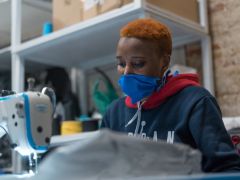 D-2388 What’s the Best Material for a Mask?
D-2388 What’s the Best Material for a Mask?Federal health officials have now recommended that we cover our faces with fabric during the coronavirus pandemic. But what material offers the most protection?
The Centers for Disease Control and Prevention has posted a no-sew mask pattern using a bandanna and a coffee filter as well as a video on making masks using rubber bands and folded fabrics found at home.
While a simple face covering can reduce the spread of coronavirus by blocking outgoing germs from coughs or sneezes of an infected person, experts say there is more variation in how much homemade masks might protect the wearer from incoming germs, depending on the fit and quality of the material used.
Scientists around the country have taken it upon themselves to identify everyday materials that do a better job of filtering microscopic particles. In recent tests, HEPA furnace filters scored well, as did vacuum cleaner bags, layers of 600-count pillowcases and fabric similar to flannel pajamas. Stacked coffee filters had medium scores. Scarves and bandanna material had the lowest scores, but still captured a small percentage of particles.
If you don’t have any of the materials that were tested, a simple light test can help you decide whether a fabric is a good candidate for a mask.
“Hold it up to a bright light,” said Dr. Scott Segal, chairman of anesthesiology at Wake Forest Baptist Health who recently studied homemade masks. “If light passes really easily through the fibers and you can almost see the fibers, it’s not a good fabric. If it’s a denser weave of thicker material and light doesn’t pass through it as much, that’s the material you want to use.”
Researchers say it’s important to remember that lab studies are conducted under perfect conditions with no leaks or gaps in the mask, but the test methods give us a way to compare materials. And while the degree of filtration for some homemade masks seems low, most of us — who are staying home and practicing social distancing in public — don’t need the high level of protection required for medical workers. More important, any face covering is better than none, especially if worn by a person who has the virus but doesn’t know it.
The biggest challenge of choosing a homemade mask material is to find a fabric that is dense enough to capture viral particles, but breathable enough that we can actually wear it. Some items being touted online promise high filtration scores, but the material would be unwearable.
Dressing Up for Work … at Home
Yang Wang, an assistant professor of environmental engineering at Missouri University of Science and Technology, worked with his graduate students to study various combinations of layered materials — including both air filters and fabric. “You need something that is efficient for removing particles, but you also need to breathe,” said Dr. Wang, who last fall won an international award for aerosol research.To test everyday materials, scientists are using methods similar to those used to test medical masks, which everybody agrees should be saved for medical workers who are exposed to high doses of virus from seeing infected patients. The best medical mask — called the N95 respirator — filters out at least 95 percent of particles as small as 0.3 microns. By comparison, a typical surgical mask — made using a rectangular piece of pleated fabric with elastic ear loops — has a filtration efficiency ranging from 60 to 80 percent.
Dr. Wang’s group tested two types of air filters. An allergy-reduction HVAC filter worked the best, capturing 89 percent of particles with one layer and 94 percent with two layers. A furnace filter captured 75 percent with two layers, but required six layers to achieve 95 percent. To find a filter similar to those tested, look for a minimum efficiency reporting value (MERV) rating of 12 or higher or a microparticle performance rating of 1900 or higher.
The problem with air filters is that they potentially could shed small fibers that would be risky to inhale. So if you want to use a filter, you need to sandwich the filter between two layers of cotton fabric. Dr. Wang said one of his grad students made his own mask by following the instructions in the C.D.C. video, but adding several layers of filter material inside a bandanna.
Dr. Wang’s group also found that when certain common fabrics were used, two layers offered far less protection than four layers. A 600 thread count pillow case captured just 22 percent of particles when doubled, but four layers captured nearly 60 percent. A thick woolen yarn scarf filtered 21 percent of particles in two layers, and 48.8 percent in four layers. A 100 percent cotton bandanna did the worst, capturing only 18.2 percent when doubled, and just 19.5 percent in four layers.
The group also tested Brew Rite and Natural Brew basket-style coffee filters, which, when stacked in three layers, showed 40 to 50 percent filtration efficiency — but they were less breathable than other options.
If you are lucky enough to know a quilter, ask them to make you a mask. Tests performed at the Wake Forest Institute for Regenerative Medicine in Winston-Salem, N.C., showed good results for homemade masks using quilting fabric. Dr. Segal, of Wake Forest Baptist Health, who led the study, noted that quilters tend to use high-quality, high-thread count cotton. The best homemade masks in his study were as good as surgical masks or slightly better, testing in the range of 70 to 79 percent filtration. Homemade masks that used flimsier fabric tested as low as 1 percent filtration, Dr. Segal said.
The best-performing designs were a mask constructed of two layers of high-quality, heavyweight “quilter’s cotton,” a two-layer mask made with thick batik fabric, and a double-layer mask with an inner layer of flannel and outer layer of cotton.
Bonnie Browning, executive show director for the American Quilter’s Society, said that quilters prefer tightly woven cottons and batik fabrics that stand up over time. Ms. Browning said most sewing machines can handle only two layers of fabric when making a pleated mask, but someone who wanted four layers of protection could wear two masks at a time.
Ms. Browning said she recently reached out to quilters on Facebook and heard from 71 people who have made a combined total of nearly 15,000 masks. “We quilters are very much in the thick of what’s going on with this,” said Ms. Browning, who lives in Paducah, Ky. “One thing most of us have is a stash of fabric.”
People who don’t sew could try a folded origami mask, created by Jiangmei Wu, assistant professor of interior design at Indiana University. Ms. Wu, who is known for her breathtaking folded artwork, said she began designing a folded mask out of a medical and building material called Tyvek, as well as vacuum bags, after her brother in Hong Kong, where mask wearing is common, suggested it. (DuPont, the maker of Tyvek, said in a statement that Tyvek is intended for medical apparel, not masks.) The folded mask pattern is free online, as is a video demonstrating the folding process. In tests at Missouri University and University of Virginia, scientists found that vacuum bags removed between 60 percent and 87 percent of particles. But some brands of vacuum bags may contain fiberglass or are harder to breathe through than other materials, and shouldn’t be used. Ms. Wu used a bag by EnviroCare Technologies, which has said it does not use fiberglass in its paper and synthetic cloth bags.
“I wanted to create an alternative for people who don’t sew,” said Ms. Wu, who said she is talking to various groups to find other materials that will be effective in a folded mask. “Given the shortage of all kinds of materials, even vacuum bags might run out.”
The scientists who conducted the tests used a standard of 0.3 microns because that is the measure used by the National Institute for Occupational Safety and Health for medical masks.
Linsey Marr, a Virginia Tech aerosol scientist and an expert in the transmission of viruses, said the certification method for respirators and HEPA filters focuses on 0.3 microns because particles around that size are the hardest to catch. While it seems counterintuitive, particles smaller than 0.1 microns are actually easier to catch because they have a lot of random motion that makes them bump into the filter fibers, she said.
“Even though coronavirus is around 0.1 microns, it floats around in a wide range of sizes, from around 0.2 to several hundred microns, because people shed the virus in respiratory fluid droplets that also contain lots of salts and proteins and other things,” said Dr. Marr. “Even if the water in the droplets fully evaporates, there’s still a lot of salt and proteins and other gunk that stays behind as solid or gel-like material. I think 0.3 microns is still useful for guidance because the minimum filtration efficiency will be somewhere around this size, and it’s what NIOSH uses.”
Learn More -
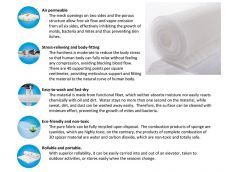 HPFJ-1111 POLYMAT FOR UPHOLSTERY, MATTRESS TOPPERS, MATS AND SEAT CUSHIONS
HPFJ-1111 POLYMAT FOR UPHOLSTERY, MATTRESS TOPPERS, MATS AND SEAT CUSHIONS• Air permeable
The mesh openings on two sides and the porous structure allow free air flow and vapor emission from all six sides, effectively inhibiting the growth of molds, bacteria and mites and thus preventing skin itches.• Stress-relieving and body-fitting
The hardness is moderate to reduce the body stress so that human body can fully relax without feeling any compression, avoiding blocking blood flow. There are 40 supporting points per square centimeter, providing meticulous support and fitting the material to the natural curve of human body.• Easy-to-wash and fast-dry
The material is made from functional fiber, which neither absorbs moisture nor easily reacts chemically with oil and dirt. Water stays no more than one second on the material, while sweat, dirt, and dust can be washed away easily. Therefore, the surface can be cleaned with minimum effort, preventing the growth of mites and bacteria.• Eco-friendly and non-toxic
The pure fabric can be fully recycled upon disposal. The combustion products of sponge are cyanides, which are highly toxic; on the contrary, the products of complete combustion of 3D spacer material are water and carbon dioxide, which are non-toxic and totally safe.• Rollable and portable.
With superior rollability, it can be easily carried into and out of an elevator, taken to outdoor activities, or stores easily when the seasons change.
Learn More
CONSTRUCTED OF 100% POLYESTER
FEATURES: AIR-PERMEABLE, WATER-PERMEABLE, ECO-FRIENDLY, NON-TOXIC, 100% RECYCLED, ANTI-STATIC, ANTI-MITE, ELASTIC, FLAME-RETARDANT, ETC.
NET “X” STRUCTURE
FOR UPHOLSTERY, MATTRESS TOPPERS, MATS, SEAT CUSHIONS, ETC.
NO# NAME LENGTH x WIDTH DIMENSIONS APPROX. INCHES THICKNESS
1 CUSHION 450x450mm 17.7 x 17.7 8 INCHES
2 BABY BED 600x1200mm 23.6 x 47.2 8 INCHES
3 STUDENT BED 1000x2000mm 39.3 x 78.7 8 INCHES
4 1.2 METER BED 1200x2000mm 47.2 x 78.7 8 INCHES
5 1.5 METER BED 1500x2000mm 59 x 78.7 8 INCHES
6 1.8 METER BED 1800x2000mm 70.8 x 78.7 8 INCHES
7 QUEEN BED 1524 x 2032mm 60 x 80 8 INCHES -
 R-3263 DIEDRICH IR-24U ROASTER & EQUIPMENT - 24 KILOS, YEAR 2008
R-3263 DIEDRICH IR-24U ROASTER & EQUIPMENT - 24 KILOS, YEAR 2008R-3263 DIEDRICH IR-24U ROASTER & EQUIPMENT - 24 KILOS, YEAR 2008
VERY UNUSUAL THAT WE GET SUCH A COMPLETE ROASTING LINE AND HAVE ALL OF IT BE FROM THE SAME DIEDRICH MANUFACTURER. ALL COORDINATED ACCORDING TO COLOR AND IMAGE. NOTICE THAT THERE IS A COFFEE BAG ATTACHED TO THE OUTLET AIR OF THE DE-STONER - BUT THAT CAN BE VENTED TO THE OUTSIDE WORLD AS WELL - JUST A LONG AS YOU ARE NOT BLOWING COFFEE DUST ALL OVER THE PLANT. IN THE FACE OF THE ROASTER - SOME OF THE ORIGINAL PAINT HAS PEELED BACK DUE TO HEAT - AND THE GOOD NEWS IS THAT MOST ANY AUTO PARTS STORE HAS HIGH TEMP PAINT FOR MOTORCYCLE EXHAUST AND ENGINE BLOCKS - SO TOUCH UP FOR THAT AREA IS SIMPLE.
MECHANICALLY - THIS MACHINE HAS BEEN ALL MAINTAINED BY THE SAME PERSON SINCE IT WAS NEW 6.5 YEARS AGO - SO THAT IS REALLY GOOD. THE LAST USE WAS JUNE OF 2015 (REPLACED BY LARGER MACHINE) AND HAS BEEN SITTING EVER SINCE AND NOW IS IN THE WAY OF GREEN STORAGE SO ANXIOUS TO GET IT OUT OF THE WAY. FULL CRATING WILL BE NEEDED AND I THINK THAT IT WOULD ALL FIT INTO A 20 FOOT CONTAINER. A MODEST FEE FOR CRATING, BLOCKING AND CONTAINER LOADING WILL BE NEEDED.
ELECTRICAL ON THIS EQUIPMENT IS 230 VOLT 50/60HZ AS THE MOTORS ARE ALL DUAL VOLTAGE.
NATURAL GASQUANTITY: 1
Learn More -
 M-2042 WISCONSIN OVEN GAS FIRED BATCH OVEN FOR TEMPERING MATTRESS INNERSPRINGSREFERENCE NUMBER: M-2042 (770IDFGXX6) WISCONSIN OVEN GAS FIRED BATCH OVEN FOR TEMPERING MATTRESS INNERSPRINGS GAS FIRED BATCH OVEN MANUFACTURER: WISCONSIN OVEN STILL ASSEMBLED TODAY OVEN WILL BE USED FOR TEMPERING STEEL SPRING ASSEMBLIES WITH A LOADING OF APPROXIMATELY 50 ASSEMBLIES WEIGHING APPROXIMATELY 40 POUNDS, IN THE OVEN AT A TIME THE SIZE IS BASED ON APPROXIMATELY 4 TO 5 CYCLES PER HOUR PROVIDING THE LOADING AND UNLOADING IS ACCOMPLISHED PROMPTLY THE HEATING RATE IS BASED ON A HEATING CYCLE OF APPROXIMATELY 12 MINUTES PER CYCLE THE OVEN WILL INCLUDE, BUT NOT BE LIMITED TO, THE DEISNG FEATURES OUTLINED IN OUR SPECIFICATIONS LISTED BELOW FURTHER MODIFICATIONS AND DESIGN CHANGES MAY BE INCORPORATED AT THE FINAL ENGINEERING STAGES TO PRODUCE THE BEST EQUIPMENT POSSIBLE QUANTITY AVAILABLE: 1 Learn More
M-2042 WISCONSIN OVEN GAS FIRED BATCH OVEN FOR TEMPERING MATTRESS INNERSPRINGSREFERENCE NUMBER: M-2042 (770IDFGXX6) WISCONSIN OVEN GAS FIRED BATCH OVEN FOR TEMPERING MATTRESS INNERSPRINGS GAS FIRED BATCH OVEN MANUFACTURER: WISCONSIN OVEN STILL ASSEMBLED TODAY OVEN WILL BE USED FOR TEMPERING STEEL SPRING ASSEMBLIES WITH A LOADING OF APPROXIMATELY 50 ASSEMBLIES WEIGHING APPROXIMATELY 40 POUNDS, IN THE OVEN AT A TIME THE SIZE IS BASED ON APPROXIMATELY 4 TO 5 CYCLES PER HOUR PROVIDING THE LOADING AND UNLOADING IS ACCOMPLISHED PROMPTLY THE HEATING RATE IS BASED ON A HEATING CYCLE OF APPROXIMATELY 12 MINUTES PER CYCLE THE OVEN WILL INCLUDE, BUT NOT BE LIMITED TO, THE DEISNG FEATURES OUTLINED IN OUR SPECIFICATIONS LISTED BELOW FURTHER MODIFICATIONS AND DESIGN CHANGES MAY BE INCORPORATED AT THE FINAL ENGINEERING STAGES TO PRODUCE THE BEST EQUIPMENT POSSIBLE QUANTITY AVAILABLE: 1 Learn More -
 M-5282 COSMETIC ROUND PADS PACKAGING MACHINE INTO BAGSREFERENCE NUMBER: M-5282 (1313121ANW12RX) L COSMETIC ROUND PADS PACKAGING MACHINE INTO BAGS NEW IN STOCK COSMETIC ROUND PADS PACKAGING MACHINE INTO BAGS FULLY AUTOMATIC MACHINE FOR PACKAGING ROUND PADS MADE OF COTTON OR SYNTHETIC FIBERS FOR COSMETIC USE IN DRAWSTRING BAGS AND BAGS WITH ZIPPER/ZIP-LOCK MADE OF PLASTIC MATERIAL. THE MACHINE REACHES THE MAXIMUM PERFORMANCE OF ABOUT 30 BAGS PER MINUTE. QUANTITY AVAILABLE: 1 Learn More
M-5282 COSMETIC ROUND PADS PACKAGING MACHINE INTO BAGSREFERENCE NUMBER: M-5282 (1313121ANW12RX) L COSMETIC ROUND PADS PACKAGING MACHINE INTO BAGS NEW IN STOCK COSMETIC ROUND PADS PACKAGING MACHINE INTO BAGS FULLY AUTOMATIC MACHINE FOR PACKAGING ROUND PADS MADE OF COTTON OR SYNTHETIC FIBERS FOR COSMETIC USE IN DRAWSTRING BAGS AND BAGS WITH ZIPPER/ZIP-LOCK MADE OF PLASTIC MATERIAL. THE MACHINE REACHES THE MAXIMUM PERFORMANCE OF ABOUT 30 BAGS PER MINUTE. QUANTITY AVAILABLE: 1 Learn More -
 E-6265 COMPLETE FOAM PLANT FOR SALEINVENTORY NUMBER: E-6265 COMPLETE FOAM PLANT FOR SALE: FOAM MAKING MACHINE FOAM BLOCK FORMING MACHINE MODEL F-3# HORIZONTAL CUTTER HORIZONTAL FOAM CUTTING MACHINE MODEL PQ-2150: VERTICAL CUTTER VERTICAL CUTTING MACHINE MODEL LQ-4L PEELER FOAM PEELER GRINDING MACHINE FOAM GRINDER (CRUSHING) MACHINE MODEL: FS-22 ROUND BLOCK MOLD ROUND FOAM MOLD: ROUND MOLD TO FEED PEELER MACHINE HORIZONTAL ROUND BLOCK BORING MACHINE QUANTITY AVAILABLE: 1 Learn More
E-6265 COMPLETE FOAM PLANT FOR SALEINVENTORY NUMBER: E-6265 COMPLETE FOAM PLANT FOR SALE: FOAM MAKING MACHINE FOAM BLOCK FORMING MACHINE MODEL F-3# HORIZONTAL CUTTER HORIZONTAL FOAM CUTTING MACHINE MODEL PQ-2150: VERTICAL CUTTER VERTICAL CUTTING MACHINE MODEL LQ-4L PEELER FOAM PEELER GRINDING MACHINE FOAM GRINDER (CRUSHING) MACHINE MODEL: FS-22 ROUND BLOCK MOLD ROUND FOAM MOLD: ROUND MOLD TO FEED PEELER MACHINE HORIZONTAL ROUND BLOCK BORING MACHINE QUANTITY AVAILABLE: 1 Learn More
